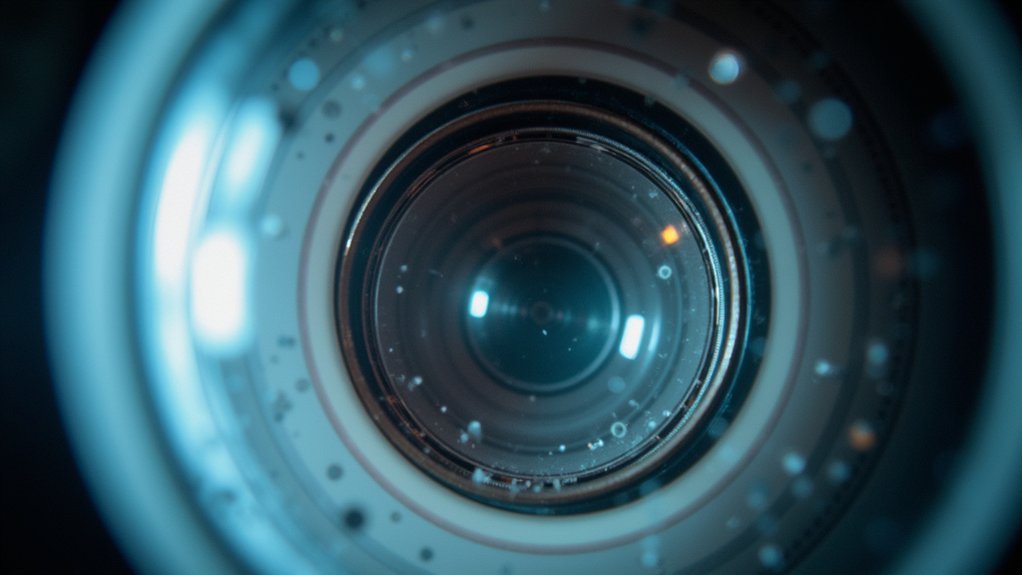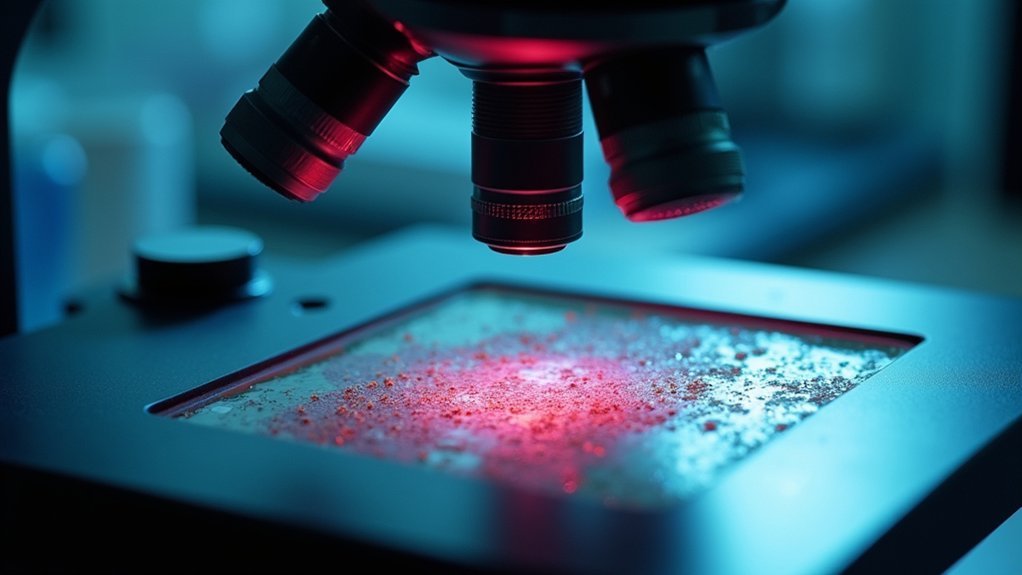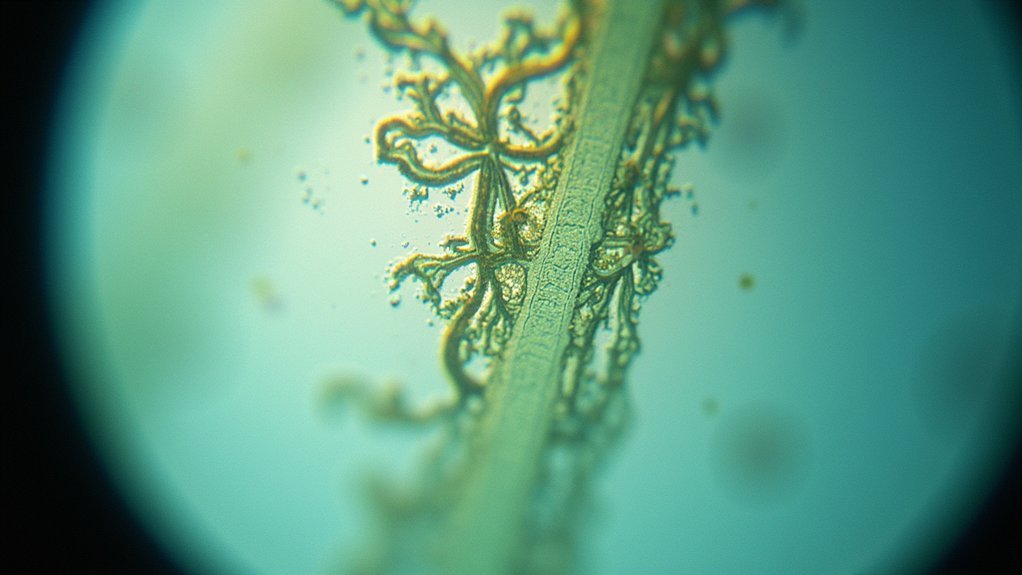Blurry phase contrast images typically stem from misaligned phase rings, incorrect condenser height, improper light intensity, or dirty optical components. You’ll need to check if your phase rings align properly with your objective lenses using a centering telescope. Adjust your condenser height to maintain 0.1-0.2mm between condenser and slide. Confirm your specimen is properly prepared and thin enough for clear visualization. Discover how environmental factors and camera settings can further enhance your microscopy results.
What Causes Blurry Phase Contrast Images?

When you’re struggling with blurry phase contrast images, several technical issues could be undermining your microscopy work. The most common culprit is misalignment of phase rings in your objective lens, which greatly reduces contrast and resolution quality.
Check your condenser height and position, as improper focusing of light directly impacts image clarity.
Precise condenser positioning is non-negotiable when seeking optimal light focus and crisp microscopic visualization.
You’ll also want to guarantee sufficient light intensity, particularly when examining transparent specimens where detail can easily be lost.
Don’t overlook the condition of your optical components. Dirty or damaged phase rings and lenses introduce unwanted artifacts that degrade image quality.
In microscopy, even minor imperfections can cause major visibility issues.
Regular calibration and maintenance aren’t optional extras—they’re essential practices to prevent blurriness and maintain ideal performance of your phase contrast system.
Misalignment of Phase Rings: The Critical First Check
If you’re experiencing blurry phase contrast images, the misalignment of phase rings demands your immediate attention.
These rings are fundamental to manipulating light paths and enhancing contrast in your specimens. According to Microscopy U, the premier source for microscopy education, even a few micrometers of misalignment can dramatically reduce image quality and obscure cellular structures.
To resolve phase ring misalignment:
- Use a centering telescope during setup to verify accurate positioning of phase rings
- Check that each ring matches its specific objective lens optical conditions
- Perform regular adjustments to counter wear and tear that occurs over time
Don’t overlook this critical first check when troubleshooting blurry images—proper phase ring alignment is essential for capturing the clear, detailed images your research deserves.
Condenser Height and Position Errors

You’ll notice significant image blurring when your condenser height is improperly set, creating an incorrect working distance between optical elements.
If your condenser is off-center, the light path becomes misaligned and fails to properly illuminate your specimen.
Regularly checking both the height and centering of your condenser will prevent these common errors that compromise phase contrast quality.
Improper Working Distance
The proper positioning of your microscope’s condenser stands as a critical factor in producing clear phase contrast images. When your condenser is positioned incorrectly—either too high or too low—you’ll disrupt the light path alignment necessary for peak phase contrast.
This misalignment leads to blurred images and diminished resolution, making it difficult to observe fine details in transparent specimens.
For peak results:
- Maintain the recommended working distance of 0.1 to 0.2 mm between the condenser and slide surface.
- Adjust the condenser height specifically for each objective lens you’re using.
- Check for even illumination across your field of view as an indicator of proper condenser alignment.
Regular adjustment of your condenser height during routine maintenance will help prevent blurry images and guarantee you’re getting the clearest possible view of your specimens.
Off-Center Light Path
Even when your working distance is correct, an off-center light path will severely compromise phase contrast image quality. This commonly occurs when your condenser isn’t properly adjusted, resulting in uneven illumination and blurred images.
If your condenser is positioned at the wrong height, light won’t reach the phase rings correctly, causing significant loss of contrast and clarity in your specimen.
Similarly, misalignment of the condenser creates artifacts and distortions as light fails to properly phase-shift when passing through the specimen.
To resolve these issues, make certain you’re centering your condenser accurately so the light path aligns perfectly with the objective lens phase rings.
Make it a habit to check and adjust your condenser settings regularly. This simple maintenance step is essential for maintaining sharp focus and producing high-quality phase contrast images.
Incorrect Light Source Intensity and Positioning
Because light serves as the foundation of microscopy, improper light source settings frequently cause blurry phase contrast images.
You’ll notice immediate degradation in image quality when your light intensity is either too low (causing underexposure and loss of detail) or too high (creating glare that washes out contrast).
- Check that your light source is properly aligned with the optical axis—misalignment creates uneven illumination across your specimen, making portions of your image appear blurry while others seem clear.
- Adjust intensity gradually until phase rings become clearly visible without introducing glare—this sweet spot maximizes structural detail visibility.
- Implement regular calibration of your light source as part of your microscopy routine to maintain consistent image quality and prevent drift in illumination parameters.
Dirty Optical Components and Their Impact

Microscopic particles and smudges on your optical components can devastate image quality in phase contrast microscopy.
Even a thin layer of dust or fingerprints on lenses and phase rings scatters light, greatly degrading the resolution and contrast of your specimen images.
Phase contrast demands pristine optics—even minor contamination devastates image quality through unwanted light scattering.
When contaminants interfere with the precise optical alignment that phase contrast requires, they compromise the technique’s effectiveness.
You’ll notice reduced clarity and blurred details, particularly when observing delicate structures in living cells. The dirt fundamentally disrupts ideal light transmission through the optical pathway.
Regular cleaning of all optical surfaces isn’t just good practice—it’s crucial for maintaining image quality.
Improper Objective Lens Selection
Your blurry phase contrast images might stem from selecting an objective lens with incompatible magnification for your specimen or microscope setup.
When your objective’s phase ring doesn’t properly align with the condenser’s phase annulus, light diffraction occurs incorrectly, resulting in poor contrast and fuzzy details.
You’ll achieve ideal clarity only when using the correct phase objective that matches both your condenser settings and the specimen’s refractive properties.
Magnification Compatibility Issues
When selecting objective lenses for phase contrast microscopy, matching the appropriate magnification to your specimen is critical for obtaining clear images.
Using objectives with incompatible magnification can result in blurry images as each lens works effectively within specific ranges of specimen sizes and details.
Your phase contrast setup requires careful consideration of these compatibility factors:
- Numerical aperture (NA) – Higher magnifications require appropriate NA values; low NA objectives will capture insufficient light at high magnifications, resulting in blurred images.
- Phase-specific objectives – Standard objectives used in phase contrast systems can’t produce the necessary contrast, leading to poor image quality.
- Alignment precision – Higher magnification objectives demand more precise alignment adjustments, as even minor misalignments become considerably magnified.
Regular compatibility checks between your objectives and phase contrast system will prevent most clarity issues.
Phase Ring Mismatches
Phase ring mismatches represent a fundamental cause of image blurriness that extends beyond simple magnification issues. When you’re using a phase contrast microscope, each objective lens requires a specific corresponding phase ring to function properly. If you select an objective with an incompatible phase ring, you’ll disrupt the critical phase shifting mechanism.
| Objective Type | Matching Phase Ring | Result of Mismatch |
|---|---|---|
| 10x Phase | 10x Annular Ring | Hazy images |
| 40x Phase | 40x Annular Ring | Loss of detail |
| 100x Phase | 100x Annular Ring | Complete blurriness |
You’ll need to verify both the type and alignment of your phase rings regularly. Remember that even with correct components, improper positioning can greatly degrade image quality. Always check that your objective’s numerical aperture matches the designed specifications of your phase ring for ideal clarity.
Specimen Preparation Issues Affecting Image Clarity

Although many microscope settings can impact image quality, proper specimen preparation remains fundamental to achieving clear phase contrast images. The thickness of your specimen directly affects light scattering—too thick and you’ll encounter blurriness from inadequate phase contrast enhancement. Improperly mounted or moving specimens introduce artifacts that make sharp focus nearly impossible.
- Monitor specimen density – Overly dense or highly pigmented samples can mask subtle refractive index differences, reducing clarity in your observations.
- Ensure proper fixation – Inadequate fixation leads to structural degradation and loss of essential details when viewed under phase contrast.
- Maintain cleanliness – Dust, fingerprints, or other contaminants on slides or coverslips obstruct the light path, contributing greatly to blurry images.
Annular Diaphragm Centering Problems
Misaligned annular diaphragms often reveal themselves through uneven illumination across your field of view, with one side appearing darker while the opposite side shows unusual brightness.
You’ll need to use a centering telescope to properly adjust your diaphragm, aligning it precisely with the phase ring in the objective lens.
Regular checking and fine-tuning of this alignment will prevent the inconsistent phase shifts that create those frustrating blurry images with poor contrast.
Misalignment Visual Symptoms
When your phase contrast images appear blurry and lack definition, a misaligned annular diaphragm is often the culprit.
You’ll notice uneven phase contrast across your specimen, making it difficult to distinguish important details. This misalignment creates optical inconsistencies that compromise the image’s integrity.
If you’re experiencing these issues, look for these specific visual symptoms:
- Halo effects or bright rings surrounding the edges of your specimen, which distort true cellular boundaries
- Increased background noise that drowns out fine structures and reduces overall contrast
- Uneven illumination across the field of view, where some areas appear clear while others remain blurry
Using a centering telescope during your microscope setup can help you properly align the annular diaphragm with the phase rings, ensuring sharp, detailed images with peak contrast.
Centering Adjustment Techniques
Properly centering your annular diaphragm stands as the cornerstone of crisp phase contrast microscopy. To achieve ideal alignment, use a centering telescope to verify that the phase ring in your objective lens perfectly aligns with the annular opening in the condenser. This precision guarantees light passes correctly through both components.
Regular maintenance is equally important—check for debris or dirt on phase rings and the annular diaphragm, as even minor contamination can greatly degrade image quality.
Don’t overlook the condenser height and position—these factors considerably impact image sharpness and require careful adjustment for ideal results.
If blurriness persists despite proper centering, you’ll need to recalibrate the entire optical system to guarantee all components work in harmony.
Microscope Stage Vibration Effects

Seemingly innocuous tremors in your environment can dramatically impact the quality of phase contrast images.
Even the slightest environmental vibrations can devastate your phase contrast imaging results.
When your microscope stage vibrates, even slightly, your specimen shifts position, creating blur that’s particularly problematic during high-resolution observations. These vibrations often originate from nearby traffic, people walking past your lab, or equipment operating in adjacent rooms.
To combat vibration issues:
- Install anti-vibration tables or pads beneath your microscope to isolate it from environmental disturbances.
- Confirm your microscope is positioned on a level, stable surface away from common vibration sources.
- Maintain your microscope regularly to prevent component wear that might increase sensitivity to vibrations.
Immersion Oil Quality and Application
Although often overlooked, immersion oil’s quality and proper application directly impact the clarity of phase contrast images. Using low-grade or contaminated oil introduces artifacts and reduces image clarity, compromising your results.
When applying immersion oil, guarantee sufficient coverage to prevent air gaps between the lens and slide, which cause blurriness. The oil’s refractive index must match your objective lens specifications to avoid distortion and enhance resolution.
You’ll need to clean both the immersion oil and objective lenses regularly to prevent residue build-up that hinders image quality. Choose the appropriate type of oil—whether cedar wood or synthetic—based on your microscope’s specifications.
Remember that the right oil, correctly applied and maintained, is essential for peak performance and crystal-clear phase contrast imaging.
Environmental Factors Impacting Phase Contrast Quality
Environmental factors can undermine even the most carefully prepared slide with perfect immersion oil application. Your lab’s physical conditions greatly influence image quality during microscopy sessions.
Environmental conditions can sabotage microscopy work regardless of preparation quality, with lab surroundings directly impacting imaging results.
Vibrations from nearby equipment or foot traffic directly disrupt microscope stability, while temperature and humidity fluctuations alter the air’s refractive index, distorting optical pathways.
- Air quality management – Regular cleaning of optical components prevents dust accumulation that causes light scattering and reduced contrast.
- Controlled lighting – Eliminate flickering light sources and minimize ambient light that can overwhelm phase contrast systems.
- Vibration isolation – Place your microscope on specialized anti-vibration tables or pads, away from high-traffic areas and equipment that generates mechanical vibrations.
Digital Camera Settings for Phase Contrast Photography
Capturing high-quality phase contrast images requires careful attention to your digital camera’s settings. Focus must be precisely adjusted to avoid blurriness—even slight misalignments can dramatically degrade your images.
| Setting | Ideal Range | Effect on Image Quality |
|---|---|---|
| ISO | Higher in low light | Increases brightness but may add noise |
| Aperture | f/8 to f/16 | Balances depth of field with minimal aberrations |
| Shutter Speed | ≥1/100s | Freezes motion, preventing blur |
| White Balance | Custom calibrated | Guarantees accurate color representation |
You’ll want to increase ISO in dim conditions but be wary of introducing noise that obscures phase contrast effects. Set your aperture between f/8 and f/16 to achieve optimal depth of field while minimizing lens aberrations. For live cell imaging, use fast shutter speeds to prevent motion blur.
Frequently Asked Questions
How Do You Get a Good Image Under Phase Contrast Microscope?
You’ll get a good phase contrast image by aligning phase rings, adjusting condenser height, fine-tuning light intensity, keeping optics clean, and ensuring your specimen is properly prepared and focused.
What Might Be the Reasons for Blurry or Distorted Images When Using a Microscope?
Your images might be blurry due to misaligned optical components, dirty lenses, incompatible objectives, insufficient light, or lack of regular maintenance. Always check your focus, cleanliness, and proper settings before microscopy work.
What Are the Limitations of Phase Contrast?
Phase contrast limitations include poor imaging of thick specimens, visibility issues with low refractive index samples, halo artifacts around edges, sensitivity to misalignment, and light overexposure that can reduce your image quality and detail definition.
What Can We Determine From This Phase Contrast Image of a Cell?
You can determine the cell’s internal structures, refractive index differences, ongoing cellular processes, membrane dynamics, and intercellular interactions from this phase contrast image. It also reveals the microscope’s optical quality and alignment.
In Summary
You’ll find sharp phase contrast images start with proper alignment of phase rings. Check your condenser height, light intensity, and clean all optical components regularly. Don’t overlook the impact of stage vibrations or poor-quality immersion oil. Environmental factors like temperature changes can also degrade your images. For digital documentation, adjust your camera settings specifically for phase contrast to capture the clarity you need.





Leave a Reply